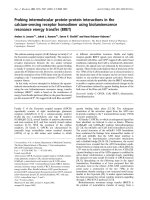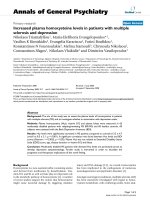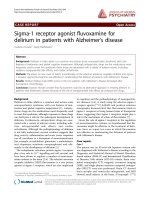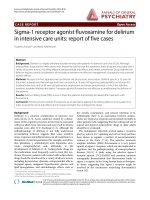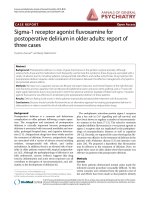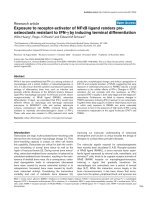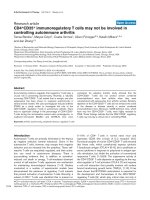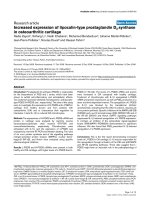Báo cáo y học: "Increased interleukin-23 receptor+ T cells in peripheral blood mononuclear cells of patients with systemic lupus erythematosu" doc
Bạn đang xem bản rút gọn của tài liệu. Xem và tải ngay bản đầy đủ của tài liệu tại đây (633.48 KB, 11 trang )
RESEARC H ARTIC LE Open Access
Increased interleukin-23 receptor
+
T cells in
peripheral blood mononuclear cells of patients
with systemic lupus erythematosus
Hathaipat Puwipirom
1
, Nattiya Hirankarn
1,2,3*
, Pimpayao Sodsai
1
, Yingyos Avihingsanon
1,4
,
Jongkonnee Wongpiyabovorn
1,2,3
, Tanapat Palaga
2,5*
Abstract
Introduction: Systemic lupus erythematosus (SLE) is an autoimmune disorder characterized by production of
autoantibodies and immune complex deposition in various organs. Aberrations in the T lymphocyte compartment
and dysregulated cytokine production are key features of SLE pathogenesis and disease progression. Recently, the
role of the interleukin (IL)-17/IL-23 axis in the pathogenesis of SLE has been reported. IL-23 and IL-23R are essential
for expansion of pathogenic IL-17-producing T lymphocytes and have been shown to be important in the
pathogenesis of lupus in animal models.
Methods: In this study, the expression of IL-23R and IL-17 in CD4
+
and CD8
+
T lymph ocytes in peripheral blood
mononuclear cells (PBMCs) of SLE patients and control subjects were examined by flow cytometry. Twenty-nine
SLE patients and 10 control subjects were recruited in this study. Patients were divided into active and inactive
groups based on the SLE disease activity index (SLEDAI). As another disease control population, five psoriatic
patients were recruited in this study.
Results: Percentages of both IL23R
+
CD4
+
and IL-23R
+
CD8
+
T cell subsets were significantly higher in freshly
isolated PBMCs from both groups of SLE patients compared to control subjects (P = 0.0021 and P = 0.0006,
respectively). In addition, this difference was maintained after ex vivo stimulation with plate-bound anti-CD3/CD28
antibodies (P = 0.007 and P = 0.0019, respect ively). When the fold increase in IL-17
+
T cells after ex vivo stimulation
for three days was compared between patients and controls, SLE patients exhibited significantly higher increases in
CD4
+
IL-17
+
and CD8
+
IL-17
+
T cells, suggesting that PBMCs from SLE patients promoted the expansion of IL-17-
producing T cells upon stimulation more vigorously than control PBMCs. These trends were not observed in
psoriasis patients. The correlations between IL-23R
+
T cells and IL-17
+
T cells and IL-23R
+
CD8
+
T cells and SLEDAI
scores in patients were also found to be statistically significant.
Conclusions: The results of our study confirmed the relevance of the IL-23/IL-17 axis in the pathogenes is of SLE
and further highlighted the importance of IL-23R
+
T cell subsets in this autoimmune disease.
Introduction
Systemic lupus erythematosus (SLE) is an autoimmune
disorder that affects multiple organs and is characterized
by production of autoantibodies and immune complex
deposition in various organs, leading to inflammation
and tissue destruction. T lymphocytes and their cyto-
kines play essential roles in the immunopathogenesis of
the disease [1]. Studies on cytokine profiles in SLE
patients revealed a complex interplay between pro-
inflammatory and anti-infla mmato ry cytokine netw orks
[2]. It is, however, still controversial whether SLE can be
simply categorized as a Th1/Th2 or other he lper T cell
type of autoimmune disease.
* Correspondence: ;
1
Lupus Research Unit, Chulalongkorn University, Phayathai Road,
Pathumwan, Bangkok 10330, Thailand
2
Medical Microbiology Interdisciplinary Program, Graduate School,
Chulalongkorn University, Phayathai Road, Pathumwan, Bangkok 10330,
Thailand
Full list of author information is available at the end of the article
Puwipirom et al. Arthritis Research & Therapy 2010, 12:R215
/>© 2010 Puwipirom et al.; licensee BioMed Central Ltd. This is an open access article distributed under the terms of the Creative
Commons Attribution License (ht tp://creativecomm ons.org/licenses/by/2.0), which permits unrestricted use, distribution, and
reproduction in any medium, provided the original wor k is properly cited.
IL-23 is a heterodimeric cytokine produced predomi-
nantly by activated antigen presenting cells, such as
macrophages and dendritic cells. The cytokine is com-
posed of a unique p19 subunit and a p40 subunit that is
shared with the Th1 signature cytokine, IL-12 [3]. Dis-
covery of IL-23 led to the identification of a unique
helper T cell subset called Th17 cells, which mainly pro-
duce the pro-inflammatory cytokines, IL-17 (A and F)
and IL-21. IL-17 can be produced by several types of
cells, including CD4
+
T cells (Th17), CD8
+
Tcells,CD3
+
CD4
-
CD8
-
T cells, g
δ
T cells, NK cells and neutrophils
[4]. IL-17 was initially associated with a Th1-type pro-
inflammatory response and pathogenesis of Th1-type
autoimmune diseases, but the realization that IL-23p19-
and IL-12p40-de ficient mice showed distinct phenoty pes
in terms of susceptibility to autoimmune diseases helped
to establish Th17 as a unique helper T cell subset distinct
from Th1 and Th2 cells [5,6]. The major transcription
factors that regulate differentiation of Th17 cells are
RORgtandRORa [7]. Cytokines produced by Th17 cells
are highly pro-inflammatory and are now associated with
various autoimmune diseases, such as psoriasis, rheuma-
toid arthritis and inflammatory bowel disease [4]. Differ-
entiation of human naïve T cells into Th17 cells is
regulated by TGFb inthepresenceofIL-21orthecom-
binations of IL-6/IL-23/IL-1b and TNFa [8]. Although
IL-23 plays only a minor role in the differentiation of
Th17 from naïve T cells, it is necessary for driving the
expansion of Th17 cells and is involved in the pathology
of various autoimmune diseases [9]. Mechanisms leading
to IL-17 production in other cell types besides helper T
cells are not well understood.
The IL-23/IL-17 axis, therefore, is one of the main
cytokine axes driving the pathogenesis of various auto-
immune diseases, a role that had been previously attrib-
uted to Th1 cells. The receptor for IL-23 is composed
of IL-12Rb1, a common subunit shared with IL-12R,
and a unique IL-23R [10]. IL-23R is not expressed in
naïve T cells, but high levels of expression are found in
act ivated/memory T cells. In addition to T cells, mono -
cytes/macrophages, NK and dendritic cells also express
IL-23R [11].
Since the identification of the Th17 lineage and its
associated cytokines, multiple reports have documented
the involvement of the IL-23/IL-17 axis in animal mod-
els of SLE and in SLE patients [4]. Sera IL-23 and IL-17
levels and the number of Th17 cells were elevated in
SLE patients compared to control subjects [12]. Further-
more, the subset of CD4
-
CD8
-
double negative T cells
was uniquely expand ed and identified as a source of IL-
17 in PBMCs and kidney biopsies from patients with
SLE [13]. The results of most studies to date now imply
that the cytokine milieu in SLE patients, such as low IL-
2 and high IL-6/IL-21, may favor the differentiation of
T cells into Th17 cells [2]. Taken together, the IL-23/
IL-17 axis s ignificantly contributes to the pathogenesis
of SLE. In another autoimmune disease of chronic
inflammatory skin, psoriasi s, IL-23/Th17 axis is impli-
cated in pathogenesis of the disease [14]. Increased
mRNA expression of IL-23p19 and IL-12p40 were found
in psoriatic skin lesions, and increased in circulating
Th1, Th17 and Th22 were found in psoriasis [15]. In
addition, single nucleotide polymorphisms in IL23R
gene were reported to affect psoriatic phenotypes, which
strongly link this disease with IL-23/Th17 axis [16].
In this study, we investigated the expression profile of
IL-23R and IL-17 in T lymphocytes of PBMCs from SLE
patients and examined its correlation with disease sever-
ity. We found significant increases in IL-23R
+
Tlym-
phocytes in SLE patients regardless of disease severity,
but this trend was not observed in psoriasis. Further-
more, we found significantly increased IL-17
+
CD4
+
and
CD8
+
T cells in SLE patients and a positive correlations
between IL-23R
+
and IL-17
+
T cells, IL-23R
+
T cells
and SLEDAI scores in SLE patients.
Materials and methods
Patients and normal subjects
Twenty-nine Thai SLE patients were recruited from King
Chulalongkorn Memorial Hospital and Bhumibol Adu-
lyadej Hospital (Bangkok, Thailand). Diagnosis of SLE
was established according to the Revised American Col-
lege of Rheumatology (ACR) criteria, and disease acti vity
was evaluated by the SLE disease activity index (SLEDAI)
2000 score. Active SLE disease was def ined as a SLEDAI-
2K score of ≥6 and inactive SLE disease was defined as a
SLEDAI-2K score of <6 [17,18]. Recruited patients were
classified into two groups, SLE patients with active SLE
(active group, n = 13) and SLE patients with inactive SLE
(inactive group, n = 16). Normal subjects were recruited
as healthy controls. Psoriatic patients were recruited
from King Chulalongkorn Memorial Hospital. The
demographic data o f subjects recruited in this study and
the treatment each patient received are summarized in
Table 1, 2 and 3. This study was approved by the Ethics
Committee for Human Research of the Faculty of Medi-
cine, Chulalongkorn University, and informed consent
was obtained from all subjects.
Antibodies
For cell surface staining, anti-CD4-APC and anti-CD8-
PerCP antibodies and FITC conjugated-streptavidin
were purchased from BD Biosciences (San Die go, CA,
USA); biotinylated anti-IL-23 receptor antibody was
obtained from R&D Systems (Minneapolis, MN, USA).
Staining for intracellular cytokines was performed
with the anti-IL-17A-PE antibo dy purchased from
eBioscience (San Diego, CA, USA).
Puwipirom et al. Arthritis Research & Therapy 2010, 12:R215
/>Page 2 of 11
Table 1 Demographic data of subjects recruited in this study
Characteristics Active SLE Group Inactive SLE Group Psoriasis Group Control Group
Numbers 13 16 5 10
Sex, female:male 12:1 16:0 3:2 10:0
Age, years 15 to 50 17 to 50 39 to 61 24 to 28
(mean ± S.D.) (34.62 ± 11.46) (33 ± 11.16) (51 ± 9.88) (25.6 ± 1.58)
SLEDAI score ≥ 6<6
(mean ± S.D.) (12.92 ± 7.83) (2.56 ± 2.03)
Range of PASI score 11.2 to 27
(mean ± S.D.) - - (18.02 ± 5.38) -
Treatment (mg/day)
(mean ± S.D.)
Prednisolone 13.13 ± 10.06 9.38 ± 8.45 - -
Cyclophosphamide - 25 - -
Azathioprine 50 ± 30.62 47.5 ± 33.54 - -
Mycophenolate mofetil 1,250 - - -
Methotrexate - - 6.43
Table 2 Detailed characteristics of SLE patients included in this study
No. Patients Stage Treatments Doses (mg/d) SLEDAI score Clinical Features
1 inactive - - 4 PI
2 inactive PRD, AZT 5, 50 0 -
3 inactive PRD, AZT 35, 12.5 4 RA, MU
4 inactive PRD, AZT 5, 25 1 FE
5 inactive PRD N/A 5 RA, MU, FE
6 inactive PRD 2.5 0 -
7 inactive PRD, CPM 10, N/A 4 PU
8 inactive PRD 5 4 AR
9 inactive - - 4 PU
10 inactive PRD 5 0 -
11 inactive PRD, AZT 10, 50 4 PU
12 inactive PRD, CPM 7.5, 25 0 -
13 inactive PRD, CPM 10, 25 4 PU
14 inactive PRD 10 2 MU
15 inactive PRD, AZT 7.5, 100 5 PU, LP
16 inactive - - 0 -
17 active PRD, AZT 5, 100 8 HE, PU
18 active - - 8 HE, PU
19 active PRD, MMF 2.5, 2,000 8 HE, PU
20 active PRD 15 30 SZ, UC, HE, PU, PI, PE, LC, IDB
21 active PRD, AZT 5, 25 11 MY, HE, PL, LP
22 active PRD 5 8 AR, PU
23 active PRD, AZT 30, 50 29 VA, AR, HE, PU, PI, RA, MU, LP
24 active PRD 30 11 PU, AL, PL, FE, TC, LP
25 active PRD, AZT 5, 50 8 VA
26 active PRD, MMF 5, 500 13 HE, PU, AL, MU, LP
27 active PRD 20 12 HE, PU, PI
28 active PRD, AZT 20, 25 16 VA, PU, MU, LC
29 active PRD 15 6 PU, LC
AL, alopecia; AR, arthritis; AZT, azathioprine; CPM, cyclophosphamide; FE, fever; HE, hematuria; IDB, Increased DNA binding; LC, low complement; LP, leucopenia;
MMF, mycophenolate mofetil; MU, mucosal ulcers; MY, myositis; N/A, data not available; PE, pericarditis; PI, pyuria; PL, pleurisy; PRD, prednisolone; PU, proteinuria;
RA, rash; SZ, seizure; TC, thrombocytopenia; UC, urinary casts; VA, vasculitis.
Puwipirom et al. Arthritis Research & Therapy 2010, 12:R215
/>Page 3 of 11
Isolation and ex vivo culture of PBMCs
Seventeen milliliters of venous peripheral blood from
patients and normal subjects was collected in ACD
bloo d collec tion tubes (BD Pharmingen, San Diego, CA,
USA). P BMCs were isolated by Ficoll-Hypaque Isoprep
(Robbins Scientific, Sunnyvale, CA, USA). Isolated
PBMCs (1 × 10
6
cells/ml) were immediately stained
with cell surface markers and intracellular cytokines
(referred to as Day 0) or incubated (1 × 10
6
cells/ml/
well) in 24-well tissue culture plates pre-coated with
anti-CD3 and anti-CD28 antibodies (1 μg/ml) (BD Phar-
mingen) in RPMI-1640 medium supplemented with 10%
heat-inactivated fetal bovine serum, 100 U/mL of peni-
cillin, 100 μg/ml of streptomycin and non-essential
amino acids (GIBCO BRL, Karlsruhe, Germany) for 72
hours (referred to as Day 3). Ex vivo stimulated PBMCs
were harvested and stained with cell surface markers
and intracellular cytokines using the antibodies
described above, and the data were analyzed by flow
cytometry.
Cell surface and intracellular cytokine staining
Cells t reated as indicated were resuspended in staining
buffer (PBS s upplemented with 0.02% sodium azide and
1% BSA). The conjugated antibodies for cell surface
staining were added and cells were incubated at 4°C in
the dark for 30 minutes. This step was followed by
washing and fixing in 4% paraformaldehyde (Sigma-
Aldrich, St. Louis, MO, USA) for 20 minutes at room
temperature in the dark. Fixed cells were washed and
resuspended in permeabilization buffer (PBS supplemen-
ted with 0.04% sodium azide, 0.1% BSA and 0.1% sapo-
nin) for 10 minutes at ro om temperature in the dark.
The anti-IL-17-PE antibody was added to cells and the
mixture was incubated for 30 minutes at 4°C in the dark
before analysis on a flow cytometer. All samples were
analyzed on a four-color FACSCalibur (BD Biosciences).
Data analysis was performed with Summit software 5.0
(Dako, Glostrup, Denmark).
Statistical analysis
Statistical analysis was performed using GraphPad Prism
4 software (GraphPad S oftware, San Diego, CA, USA).
Differences among groups were compared using the
Mann-Whitney U-test. Spearman’s rank correlation test
was used to assess the correlation of two variables.
Probability values of P < 0.05 were considered statisti-
cally significant. All probabilities were two-tailed.
Results
Increased IL-23R
+
T lymphocytes in PBMCs from SLE
patients
To investigate the expression profile of IL-23R and IL-
17A (referred to as IL-17) in T lymphocytes from SLE
patients, PBMCs were isolated and immediately stained
for cell surface markers (CD4, CD8 and IL-23R) and
intracellular cytokines (IL-17) (Day 0). The percentages
of CD4
+
IL-23R
+
and CD8
+
IL-23R
+
T lymphocytes were
analyzed after gating on lymphocytes. As shown in Fig-
ures 1a, c and 2a, c, PBMCs from all SLE patients,
regardless of disease activity based on SLEDAI score,
exhibited significantly higher percentages of cells that
were CD4
+
IL-23R
+
and CD8
+
IL-23R
+
than control sub-
jects (P = 0.0021 for CD4
+
and P = 0.0006 for CD8
+
T cells). When SLE patients were divided into active and
inactive groups based on SLEDAI scores, differences
between each patient group and the control subjects
remained statistically significant (Figures 1a and 2a).
However, differences between SLE patients in the active
disease stage and inactive disease stage were not detected.
Because all T cells from PBMCs may not be in a stage
of activation, we wondered whether the differences
observed above between SLE patients and normal con-
trols would be more evident after polyclonal activation ex
vivo.Uponex vivo stimulation by plate-bound anti-CD3
and anti-CD28 antibodies for three days (Day 3), the
higher proportion of CD4
+
IL-23R
+
and CD8
+
IL-23R
+
in
all SLE patients remained statistically significant com-
pared to the control group (Figure 1b, d and Figure 2b, d;
P = 0.0007 and P = 0.0019, respectively). Similar to the
results obtained from Day 0, no statistical difference was
found between inactive and active patients in percentages
of IL-23R
+
cells at Day 3. This may be due to the effect
of the higher dose of immunosuppressive drugs given to
patients in the active group. When we compared data
from SLE patients with those from psoriatic patients,
psoriat ic patients showed significantly lower percentages
of IL-23R
+
T cells than SLE patients (Figures 1a, b a nd
2a,b).Theresultsdescribedherestronglysuggestthat
SLE patients have a higher frequency of I L-23R
+
Tlym-
phocytes in PBMCs, both in CD4
+
and CD8
+
subsets,
than the control group and psoriatic group, and this dif-
ference was maintained after ex vivo stimulation.
Increase in IL-17
+
T lymphocytes in SLE patients upon
ex vivo activation
Previous reports documented an increase in IL-17
+
T
lymphocytes in PBMCs and kidney infiltrates in SLE
Table 3 Detailed characteristics of psoriasis patients
included in this study
No. of Patients PASI Score Treatments Doses (mg/d)
1 20.5 No treatment -
2 15.2 Methotrexate 2.14
3 11.2 No treatment -
4 16.2 Methotrexate 10.71
5 27 Photo NB-UVB -
Puwipirom et al. Arthritis Research & Therapy 2010, 12:R215
/>Page 4 of 11
patients [ 13]. When IL-17
+
T cells were assessed in the
same manner as described above, percentages of IL-17
+
CD4
+
and IL-17
+
CD8
+
T cells freshly isolated were not
different between control subjects and SLE patients (Fig-
ure 3a, c). In fact, some control subjects had higher per-
centages of IL-17
+
CD4
+
T cells than SLE patients. At
Day 3, after ex vivo sti mulation, PBMCs from SLE
patients showed significantly higher percentages of IL-
17
+
CD8
+
T cells than controls (P = 0.0007) but no
difference from controls in percentages of CD4
+
IL-17
+
cells (Figure 3b).
More importantly, however, when the fold increase in
CD4
+
IL-17
+
and CD8
+
IL-17
+
subsets from Day 0 to
Day 3 was analyzed, it was found that both CD4
+
and
CD8
+
subsets had significantly higher IL-17
+
staining
than the control subjects (Figure 3c, d; P = 0.0033 for
CD4
+
and P =0.0004forCD8
+
). Because the difference
in IL-17
+
T cell subsets between patients and the
Normal
In
a
ct
ive S
LE
A
c
tive SL
E
T
ot
al S
L
E
Psoriasis
0
10
20
30
40
50
%IL-23R
+
CD4
+
T cells in CD4
+
T cells Day0
N
o
r
m
al
I
nac
ti
v
eSL
E
Active SLE
To
tal
SL
E
Psoriasis
0
10
20
30
40
50
%IL-23R
+
CD4
+
T cells in CD4
+
T cells Day
3
(a) (b)
(c)
Day 0
Day 3
Normal Inactive SLE Active SLE
(d)
*p =0.0021
*p =0.0201
*p =0.0025
*p =0.0007
*p =0.0011
*p =0.0057
*p =0.0005
*p =0.0006
Figure 1 Increased percentages of IL-23R
+
CD4
+
T cells in PBMCs from SLE patients. (a, b) The percentages of IL-23R
+
CD4
+
Tcellsin
PBMCs from inactive and active SLE patients, psoriatic patients and normal subjects on Day 0 (a) and Day 3 (b) are shown. The horizontal bars
show the mean values. The percentages of IL-23R
+
CD4
+
T cells were calculated from total CD4
+
T cells after lymphocyte gating. (c, d)
Representative flow cytometric profiles of IL-23R
+
CD4
+
T cells in PBMCs from inactive (Day 0: middle panel in (c), Day 3: middle panel in (d))
and active (Day 0: right panel in (c), Day 3: right panel in (d)) SLE patients and normal subjects (Day 0: left panel in (c), Day 3: left panel in (d))
are shown.
Puwipirom et al. Arthritis Research & Therapy 2010, 12:R215
/>Page 5 of 11
controlgroupwasnotfoundatDay0,thehigherper-
centages of IL-17
+
Tcellsafterex vivo stimulation
strongly implies that T cells in the PBMCs of SLE
patients preferentially skew towards IL-17 production
and expand more vigorously than those of the control,
both in the CD4
+
and CD8
+
compartments. Investiga-
tion into whether all IL-17
+
T cells were limited to the
IL-23R
+
subset revealed that IL-17
+
Tcellsexhibited
both an IL-23R
+
and IL-23R
-
phenotype (data not
shown). No differences were found between normal
group and psoriatic patient group (Figure 3), suggesting
that the characteristic of fold increase in IL-17
+
T cells
upon ex vivo stimulation is specific for SLE but not
psoriasis.
No
rmal
Ina
cti
ve
SL
E
Activ
e
SLE
Total SLE
P
so
riasi
s
0
10
20
30
40
50
%IL-23R
+
CD8
+
T cells in CD8
+
T cells Day0
No
rmal
Inactive SLE
Acti
ve S
L
E
T
o
tal SLE
P
s
oriasis
0
20
40
60
%IL-23R
+
CD8
+
T cells in CD8
+
T cells Day3
Day 0
Day 3
Normal Inactive SLE Active SLE
(c)
(d)
(a) (b)
*p =0.0006
*p =0.0032
*p =0.0021
*p =0.0006
*p =0.0019
*p =0.0101
*p =0.0041
*p =0.0019
Figure 2 Increased percentages of IL-23R
+
CD8
+
T cells in PBMCs from SLE patients. (a, b) The percentages of IL-23R
+
CD8
+
Tcellsin
PBMCs from inactive and active SLE patients, psoriatic patients and normal subjects on Day 0 (a) and Day 3 (b) are shown. The horizontal bars
show the mean values. The percentages of IL-23R
+
CD8
+
T cells were calculated from total CD8
+
T cells after lymphocyte gating. (c, d)
Representative flow cytometric profiles of IL-23R
+
CD8
+
T cells in PBMCs from inactive (Day 0: middle panel in (c), Day 3: middle panel in (d))
and active (Day 0: right panel in (c), Day 3: right panel in (d)) SLE patients and normal subjects (Day 0: left panel in (c), Day 3: left panel in (d))
are shown.
Puwipirom et al. Arthritis Research & Therapy 2010, 12:R215
/>Page 6 of 11
Correlation between percentages of IL-23R
+
T cells and
IL-17
+
T cells in SLE patients
When the correlation between percentages of IL-23R
+
T
cells and IL-17
+
T cells was analyzed, a significant and
positive correlation was found in percentages of CD4
+
IL-23R
+
T cells and CD4
+
IL-17
+
T cells at Day 3 in the
active SLE group (r = 0.7692, P = 0.0021) and in total
SLE cases (r = 0. 5601, P = 0.0016) (Figure 4a, c). Simi-
larly, a significant and positive correlation was also
found in CD8
+
T cells at Day 3 in active and t otal SLE
patients (r = 0.5174, P = 0.0413 for active SLE and r =
0.4833, P = 0.0079 for total SLE) (Figure 4b, d). The
correlation o f IL-23R
+
T c ells and IL-17
+
T cells in the
inactive group and control subjects did not reach statis-
tical significance (data not shown). In addition, when we
analyzed the correlation between disease severity using
SLEDAI score and percentages of IL-23R
+
T cells or IL-
17
+
T cells in SLE patients, only the positive correlation
between SLEDAI and IL-23R
+
CD8
+
T cells on Day 3 in
active SLE group was found (r = 0.5462, P = 0.0535),
but it did not reached statistical significance (Figure 5b).
Further more, the correlation between percentages of IL-
17
+
T cells a nd SLEDAI sco res were observ ed only in
active S LE group (r = 0.6056, P = 0.0283 for CD4
+
and
r = 0.6085, P = 0.0273 for CD8
+
)(Figure5c,d).These
results strongly suggest that higher IL-23R
+
T cells and
higher IL-17
+
T cells (both CD4
+
and CD8
+
subsets) are
one of the characteristics exhibited by SLE patients and
may be useful biomarkers for detection of severity and
disease stage in SLE patients.
Discussion
Even though the protective role of the IL-23/IL-17 axis
is essential for certain bacterial and fungal infections, its
contribution to the immunopathology of various auto-
immune dise ases has been highlighted [19]. Recent evi-
dence, both in lupus animal models and human SLE,
strongly links the pathogenesis of SLE with the IL-23/
No
rmal
I
n
active S
L
E
Act
i
ve SLE
To
tal S
L
E
Psoriasi
s
0
2
4
6
%IL-17
+
CD4
+
T cells in CD4
+
T cells Day0
No
rmal
In
a
ct
i
ve
S
L
E
Activ
e
S
L
E
T
o
t
a
l SL
E
P
so
ri
asi
s
0
10
20
30
%IL-17
+
CD4
+
T cells in CD4
+
T cells Day3
No
rmal
I
n
active S
L
E
Act
i
ve SLE
To
tal S
L
E
Psoriasi
s
0
2
4
6
%IL-17
+
CD4
+
T cells in CD8
+
T cells Day0
Normal
I
n
acti
ve
S
L
E
Active S
L
E
T
o
t
al
SL
E
Psor
i
asi
s
0
10
20
30
%IL-17
+
CD4
+
T cells in CD8
+
T cells Day3
Normal
Inac
t
ive SLE
Acti
v
eSLE
To
t
a
lS
LE
Psoriasis
0
20
40
60
Fold increase in the percentage of CD4
+
IL-17
+
T cells
Nor
m
al
I
n
acti
ve
S
L
E
A
ctive SLE
Total SLE
P
so
ri
asis
0
10
20
30
40
F
old increase in the percentage of CD8
+
IL-17
+
T cells
(b)
(c)
(d)
IL-17
+
CD4
+
Fold Increase in IL-17
+
CD4
+
IL-17
+
CD8
+
Fold Increase in IL-17
+
CD8
+
(
a)
*p =0.0197
*p =0.0219
*p =0.0324
*p =0.007
*p =0.0120
*p =0.0007
*p =0.0033
*p =0.0324
*p =0.0029
*p =0.009
*p =0.0004
*p =0.0101
*p =0.0003
Figure 3 Increased percentages of IL-17
+
CD4
+
T cells and IL-17
+
CD8
+
T cells in PBMCs from SLE patients. (a, c) The percentages of IL-
17
+
CD4
+
T cells (a) or IL-17
+
CD8
+
T cells (c) in PBMCs from inactive and active SLE patients, psoriatic patients and normal subjects on Day 0
(left panel) and Day 3 (right panel) are shown. The horizontal bars show the mean values. (b, d) The fold increase in the percentages of IL-17
+
CD4
+
T cells (b) and IL-17
+
CD8
+
T cells (d) in PBMCs from inactive and active SLE patients, psoriatic patients and normal subjects is shown. The
percentages of IL-17
+
T cells at Day 3 were divided by those of Day 0 from individual samples and the results were presented as fold increase.
The horizontal bars show the mean values.
Puwipirom et al. Arthritis Research & Therapy 2010, 12:R215
/>Page 7 of 11
IL-17 axis [20]. Most studies have found higher num-
bers of Th17 cells or elevated Th17 cytokines in SLE
patients or lupus prone mice [12,13]. Th17-derived cyto-
kines not only trigger vicious inflammatory cycles but
also seem to provide help for B cells, which leads to
production of autoantibodies [2].
In this study, we found that PBMCs from SLE patients
contained higher percentages of IL-23R
+
Tlymphocytes
as compared to those of the control subjects. Expression
of IL-23R is reported to be restricted to effector and
memory T l ymphocytes and possibly to Th17 lineage
cells. Therefore, our data suggest that SLE patients may
have high numbers of effector and memory Th17 cells
in circulation. This is consistent with a previous study
using a lupus animal model, which showed that IL-23R-
deficiency prevented the development of lupus nephritis
in lpr/lpr mice [21]. Upon ex vivo stimulat ion, the
percentages of IL-23R
+
T lymphocytes in S LE patients
remained higher than thos e of the control subjects.
Because IL-23R can be expressed in both effector and
memory cells, it will be of interest to test whether sub-
sets of cells we detected in this study have effector or
memory phenotypes. Human Th17 cells selectively
expressing IL-17 with a memory phenotype can be
further identified by chemokine markers, including
CCR6 and CCR4 [22].
When IL-17 was assessed in samples of freshly iso-
lated PBMCs, we did not detect any statistical signifi-
cance between controls and patients. Similarly, we
found no detectable level of IL-17 in the sera of patients
in our study; when sera IL-17 was measured by ELISA,
only two sera samples from SLE patients yielded detect-
able IL-17 (5.12 and 6.17 pg/ml), while the rest of t he
samples from both the SLE patients and control subjects
0 10 20 30 40 50 60
0
10
20
30
40
r = 0.7692
p* = 0.0021
%IL-23R
+
CD4
+
T cells Day3
%IL-17A
+
CD4
+
T cells Day3
0 10 20 30 40 50 60
0
10
20
30
40
r = 0.5714
p*= 0.0413
%IL-23R
+
CD8
+
T cells Day3
%IL-17A
+
CD8
+
T cells Day3
0 10 20 30 40 50 60
0
10
20
30
40
r = 0.5601
p*= 0.0016
%IL-23R
+
CD4
+
T cells Day3
%IL-17A
+
CD4
+
T cells Day3
0 10 20 30 40 50 60
0
10
20
30
40
r = 0.4833
p*= 0.007
9
%IL-23R
+
CD8
+
T cells Day3
%IL-17A
+
CD8
+
T cells Day3
(
a) (b)
(c) (d)
Active
S
LE
T
o
t
a
l
S
LE
Active
S
LE
T
o
t
a
l
S
LE
Figure 4 Correlation between percentage of IL-23R
+
T cells and percentage of IL-17
+
T cells in SLE patients. (a, c) Relationships between
the percentage of IL-23R
+
CD4
+
T cells and the percentage of IL-17
+
CD4
+
T cells on day 3 in active (a) and total SLE (c) groups (r = 0.7692, P =
0.0021 and r = 0.5601, P = 0.0016, respectively) are shown. (b, d) A relationship between the percentage of IL-23R
+
CD8
+
T cells and the
percentage of IL-17
+
CD8
+
T cells on Day 3 was also found in active (b) and total SLE (d) groups (r = 0.5714, P = 0.0413 and r = 0.4833, P =
0.0079, respectively) are shown. Spearman’s correlation test was used to analyze these data.
Puwipirom et al. Arthritis Research & Therapy 2010, 12:R215
/>Page 8 of 11
did not reach detectable levels (data not shown). In con-
trast, other studies have reported the elevation of both IL-
17 and IL-23 in sera from patients [12]. One report, how-
ever, observed similar results in SLE patients in which no
difference in sera IL-17 was found [23]. The reasons for
the discrepancy between our results and others are not
known but may be due to the effects of drug regimens
patients recruited in this study received. Interestingly,
when we compared the fold increase in IL-17
+
T cells
from Day 0 to Day 3 upon ex vivo PBMCs stimulation, sig-
nificant differe nces were detected between the control
group and SLE patients. The positive correlation between
IL-23R
+
and IL-17
+
T cells in SLE patients further high-
lighted the importance of IL-23R
+
IL-17
+
T cells in this
disease. These data suggest that IL-17
+
T cells vigorously
expanded during ex vivo stimulation and probably reflect
the higher frequency of IL-23R
+
T cells in freshly isolated
PBMCs from SLE patients. When we analyzed data from
psoriatic patients, no detectable increase in either IL-23R
+
or IL-17
+
T cells were found. Since psoriasis is an autoim-
mune disease with both genetic and immun opathogenic
links with IL-23/Th17 axis, this is somewhat unexpected.
However, most reports on the links between psoriasis and
increases in cells or molecules of the IL-23/Th17 axis
focused on psoriatic skin lesions, and the report on
increase in circulating Th17 in psoriasis did not use IL-
23R but other markers to identify the Th17 population
[15,24]. Therefore, it is possible that increased frequency
in IL-23R
+
T cells may be a specific characteristic of SLE
but not psoriasis.
When SLE pa tients recruited in this study were classi-
fied into active and inactive groups based on disease
severity by SLEDAI score, the correlation between dis-
ease severity and percentages of IL-23R
+
or IL-17
+
T
cell s was not found in inactive SLE groups, but the cor-
relation were found in active SLE patients between IL-
23R
+
CD8
+
T cells only after ex vivo stimulation. Even
though this correlation did not reach statistical signifi-
cance, this may imply that higher percentages of IL-23R
+
T lymphocytes per se may not directly promote patho-
genesis, but perhaps the cytokines produced by these
cells act as effector molecule s in t he pathogenesis of
SLE. Upon ex vivo stimulation, these pathogenic groups
of cells are probably selectively expanded. Therefore, as
long as the immunosuppressive drugs keep the cyto-
kine-producing effector cells in check, the disease out-
come may not be a s severe, but the subsets of cells
ready to produce such pro-inflammatory cytokines may
be present in patients even when the disease is in an
inactive stage.
0 10 20 30 40 50
0
10
20
30
40
r = 0.1387
p = 0.6514
%IL-23R
+
CD4
+
T cells day0
SLEDAI-2K
0 10 20 30 40 50
0
10
20
30
40
r = 0.3141
p = 0.2959
%IL-23R
+
CD8
+
T cells day0
SLEDAI-2K
0 10 20 30 40 50
0
10
20
30
40
r = 0.2632
p = 0.3849
%IL-23R
+
CD4
+
T cells day3
SLEDAI-2K
0 10 20 30 40 50 60
0
10
20
30
40
r = 0.5462
p = 0.0535
%IL-23R
+
CD8
+
T cells day3
SLEDAI-2K
0 5 10 15 20 25 30
0
10
20
30
40
r = 0.6056
p* = 0.028
3
%IL-17
+
CD4
+
T cells day3
SLEDAI-2K
0 5 10 15 20 25 30
0
10
20
30
40
r = 0.6085
p* = 0.0273
%IL-17
+
CD8
+
T cells day3
SLEDAI-2K
(a)
(b)
(c)
(d)
Figure 5 Correlation between percentages of IL-23R
+
T cells and S LEDAI and IL-17
+
T cells and SLEDAI in active SLE patients. (a, b)
Relationships between the percentages of IL-23R
+
CD4
+
or CD8
+
T cells on Day 0 and Day 3 and SLEDAI in active SLE groups are shown. (c, d)
Relationships between the percentages of IL-17
+
T CD4
+
or CD8
+
T cells on Day 3 from SLE patients (r = 0.6056, P = 0.0283 for CD4
+
and r =
0.6085, P = 0.0273 for CD8
+
) are shown.
Puwipirom et al. Arthritis Research & Therapy 2010, 12:R215
/>Page 9 of 11
In addition, we also found that CD8
+
T lymphocytes
with an IL-23R
+
phenotype were higher in SLE patients.
Whether this subset of CD8
+
T cell also produces IL-17
in vivo and whether it plays a role in the pathogenesis
of SLE have not been documented. Recent evidence sug-
gests that IL-23/IL-23R drives pathogenic IL-17-produ-
cing CD8
+
T cells [25]. Fold increases in CD8
+
T cells
positive for IL-17 were higher in SLE patients. Interest-
ingly, expa nded, double-negative ab T cells in SLE
patients have been found to produce IL-17 and infiltrate
the kidneys, and this subset of cells can be derived from
CD8
+
T cells with an inflammatory effector phenotype
[13,26]. From this point of view, the result from our
study is consistent with these reports, and increased IL-
23R
+
CD8
+
T cells may become double-neg ative T cells
upon stimulation.
Taken together, we added anot her supportive piece of
evidence for the role of the IL-23/IL-17 axis in SLE,
suggesting that these cytokines may play a central role
in the patho genesis of the disease. The results from our
study may be useful for therapeutic intervention in SLE
patients.
Conclusions
SLE p atients, regardless of disease severity, have higher
percentages of IL-23R
+
T lymphocytes (both CD4
+
and
CD8
+
subsets) than the control subjects in PBMCs and
psoriatic patients. Upon ex vivo stimulation, PMBCs
from SLE patients preferentially expanded IL-17 produ-
cing T cells, when compared with the normal subjects.
The statistic ally significant correlation between percen-
tages of IL-23R
+
T cells and IL-17
+
T cells, and IL-17
+
T cells and SLEDAI scores were found in active SLE
patients. Taken together, this study suggests that the IL-
23/IL-17 axis is implicated in the pathogenesis of SLE.
Abbreviations
IL: interleukin; PMBCs: peripheral blood mononuclear cells; SLE: systemic
lupus erythematosus; SLEDAI: SLE disease activity index.
Acknowledgements
This work was supported in part by the Thai Government’s annual budget,
fiscal year 2008, the 90
th
Year Anniversary Ratchadapisek Somphot
Endowment Fund, CU Cluster Ratchadapisek Somphot Endowment Fund
from Chulalongkorn University, the Thai Government Stimulus Package 2
(TKK2555), under the Project for Establishment of Comprehensive Center for
Innovative Food, Health Products and Agriculture, and National Research
University project from the Commission of Higher Education (CHE). The
authors are grateful to Dr. Puchaniyada Wichentham and Supranee
Buranapraditkul for help with sample collection and flow cytometr ic analysis.
Written consent for publication was obtained from the patients or their
relatives.
Author details
1
Lupus Research Unit, Chulalongkorn University, Phayathai Road,
Pathumwan, Bangkok 10330, Thailand.
2
Medical Microbiology
Interdisciplinary Program, Graduate School, Chulalongkorn University,
Phayathai Road, Pathumwan, Bangkok 10330, Thailand.
3
Department of
Microbiology, Faculty of Medicine, Chulalongkorn University, Phayathai Road,
Pathumwan, Bangkok 10330, Thailand.
4
Department of Medicine, Faculty of
Medicine, Chulalongkorn University, Phayathai Road, Pathumwan, Bangkok
10330, Thailand.
5
Department of Microbiology, Faculty of Science,
Chulalongkorn University, Phayathai Road, Pathumwan, Bangkok 10330,
Thailand.
Authors’ contributions
All authors contributed to the design of the study, and to the acquisition
and interpretation of data. HP and PS carried out the analysis by flow
cytometry. YA, NH and JW evaluated patients’ data. TP and NH drafted the
manuscript. All authors read and approved the final manuscript.
Competing interests
The authors declare that they have no competing interests.
Received: 28 June 2010 Revised: 28 October 2010
Accepted: 29 November 2010 Published: 29 November 2010
References
1. Crispin JC, Kyttaris VC, Terhorst C, Tsokos GC: T cells as therapeutic targets
in SLE. Nat Rev Rheumatol 2010, 6:317-325.
2. Yap DY, Lai KN: Cytokines and their roles in the pathogenesis of systemic
lupus erythematosus: from basics to recent advances. J Biomed
Biotechnol 2010, 2010:365083.
3. Lankford CS, Frucht DM: A unique role for IL-23 in promoting cellular
immunity. J Leukoc Biol 2003, 73:49-56.
4. Nalbandian A, Crispin JC, Tsokos GC: Interleukin-17 and systemic lupus
erythematosus: current concepts. Clin Exp Immunol 2009, 157:209-215.
5. Harrington LE, Hatton RD, Mangan PR, Turner H, Murphy TL, Murphy KM,
Weaver CT: Interleukin 17-producing CD4+ effector T cells develop via a
lineage distinct from the T helper type 1 and 2 lineages. Nat Immunol
2005, 6:1123-1132.
6. Park H, Li Z, Yang XO, Chang SH, Nurieva R, Wang YH, Wang Y, Hood L,
Zhu Z, Tian Q, Dong C: A distinct lineage of CD4 T cells regulates tissue
inflammation by producing interleukin 17. Nat Immunol 2005,
6:1133-1141.
7. McKenzie BS, Zhou L, Tadokoro CE, Lepelley A, Lafaille JJ, Cua DJ,
Littman DR: The orphan nuclear receptor RORgammat directs the
differentiation program of proinflammatory IL-17+ T helper cells. Cell
2006, 126:1121-1133.
8. Yang L, Anderson DE, Baecher-Allan C, Hastings WD, Bettelli E, Oukka M,
Kuchroo VK, Hafler DA: IL-21 and TGF-beta are required for differentiation
of human T(H)17 cells. Nature 2008, 454:350-352.
9. Langrish CL, Chen Y, Blumenschein WM, Mattson J, Basham B, Sedgwick JD,
McClanahan T, Kastelein RA, Cua DJ: IL-23 drives a pathogenic T cell
population that induces autoimmune inflammation. J Exp Med 2005,
201:233-240.
10. Parham C, Chirica M, Timans J, Vaisberg E, Travis M, Cheung J, Pflanz S,
Zhang R, Singh KP, Vega F, To W, Wagner J, O’Farrell AM, McClanahan T,
Zurawski S, Hannum C, Gorman D, Rennick DM, Kastelein RA, de Waal
Malefyt R, Moore KW: A receptor for the heterodimeric cytokine IL-23 is
composed of IL-12Rbeta1 and a novel cytokine receptor subunit, IL-23R.
J Immunol 2002, 168:5699-5708.
11. Tan ZY, Bealgey KW, Fang Y, Gong YM, Bao S: Interleukin-23:
immunological roles and clinical implications. Int J Biochem Cell Biol 2009,
41:733-735.
12. Wong CK, Lit LC, Tam LS, Li EK, Wong PT, Lam CW: Hyperproduction of IL-
23 and IL-17 in patients with systemic lupus erythematosus: implications
for Th17-mediated inflammation in auto-immunity. Clin Immunol 2008,
127:385-393.
13. Crispin JC, Oukka M, Bayliss G, Cohen RA, Van Beek CA, Stillman IE,
Kyttaris VC, Juang YT, Tsokos GC: Expanded double negative T cells in
patients with systemic lupus erythematosus produce IL-17 and infiltrate
the kidneys. J Immunol 2008, 181:8761-8766.
14. Di Cesare A, Di Meglio P, Nestle FO: The IL-23/Th17 axis in the
immunopathogenesis of psoriasis. J Invest Dermatol 2009, 129:1339-1350.
15. Kagami S, Rizzo HL, Lee JJ, Koguchi Y, Blauvelt A: Circulating Th17, Th22,
and Th1 cells are increased in psoriasis. J Invest Dermatol 2010,
130:1373-1383.
16. Blauvelt A: T-helper 17 cells in psoriatic plaques and additional genetic
links between IL-23 and psoriasis. J Invest Dermatol 2008, 128:1064-1067.
Puwipirom et al. Arthritis Research & Therapy 2010, 12:R215
/>Page 10 of 11
17. Arce-Salinas A, Cardiel MH, Guzman J, Alcocer-Varela J: Validity of
retrospective disease activity assessment in systemic lupus
erythematosus. J Rheumatol 1996, 23:846-849.
18. Khanna S, Pal H, Pandey RM, Handa R: The relationship between disease
activity and quality of life in systemic lupus erythematosus.
Rheumatology (Oxford) 2004, 43:1536-1540.
19. Sallusto F, Lanzavecchia A: Human Th17 cells in infection and
autoimmunity. Microbes Infect 2009, 11:620-624.
20. Crispin JC, Tsokos GC: IL-17 in systemic lupus erythematosus. J Biomed
Biotechnol 2010, 2010:943254.
21. Kyttaris VC, Zhang Z, Kuchroo VK, Oukka M, Tsokos GC: Cutting edge: IL-23
receptor deficiency prevents the development of lupus nephritis in
C57BL/6-lpr/lpr mice. J Immunol 2010, 184:4605-4609.
22. Acosta-Rodriguez EV, Rivino L, Geginat J, Jarrossay D, Gattorno M,
Lanzavecchia A, Sallusto F, Napolitani G: Surface phenotype and antigenic
specificity of human interleukin 17-producing T helper memory cells.
Nat Immunol 2007, 8:639-646.
23. Kurasawa K, Hirose K, Sano H, Endo H, Shinkai H, Nawata Y, Takabayashi K,
Iwamoto I: Increased interleukin-17 production in patients with systemic
sclerosis. Arthritis Rheum 2000, 43:2455-2463.
24. Lee E, Trepicchio WL, Oestreicher JL, Pittman D, Wang F, Chamian F,
Dhodapkar M, Krueger JG: Increased expression of interleukin 23 p19 and
p40 in lesional skin of patients with psoriasis vulgaris. J Exp Med 2004,
199:125-130.
25. Ciric B, El-behi M, Cabrera R, Zhang GX, Rostami A: IL-23 drives pathogenic
IL-17-producing CD8+ T cells. J Immunol 2009, 182:5296-5305.
26. Crispin JC, Tsokos GC: Human TCR-alpha beta+ CD4-CD8-T cells can
derive from CD8+ T cells and display an inflammatory effector
phenotype. J Immunol 2009, 183:4675-4681.
doi:10.1186/ar3194
Cite this article as: Puwipirom et al.: Increased interleukin-23 receptor
+
T cells in peripheral blood mononuclear cells of patients with systemic
lupus erythematosus. Arthritis Research & Therapy 2010 12:R215.
Submit your next manuscript to BioMed Central
and take full advantage of:
• Convenient online submission
• Thorough peer review
• No space constraints or color figure charges
• Immediate publication on acceptance
• Inclusion in PubMed, CAS, Scopus and Google Scholar
• Research which is freely available for redistribution
Submit your manuscript at
www.biomedcentral.com/submit
Puwipirom et al. Arthritis Research & Therapy 2010, 12:R215
/>Page 11 of 11

